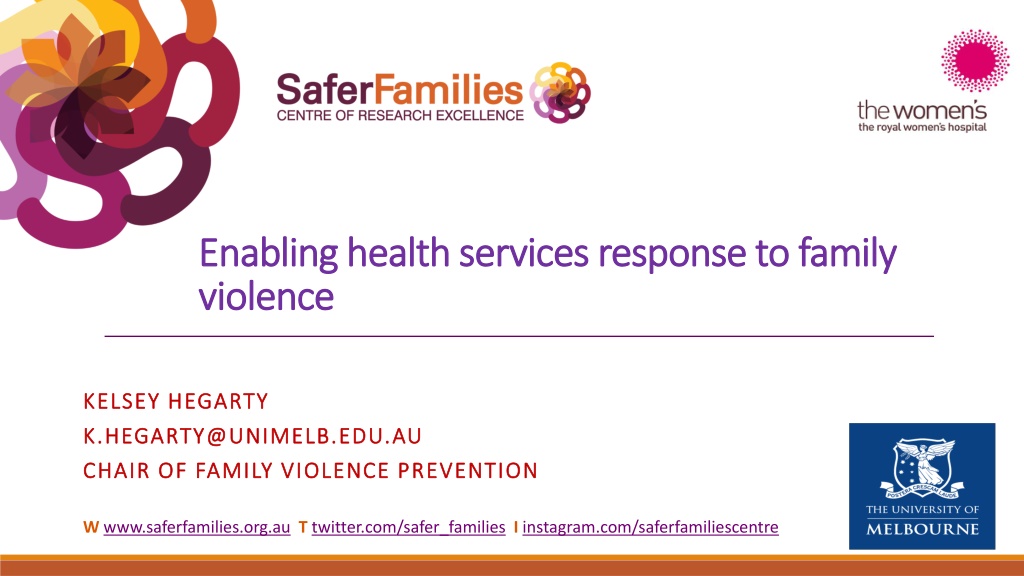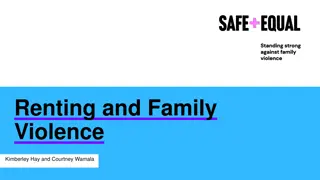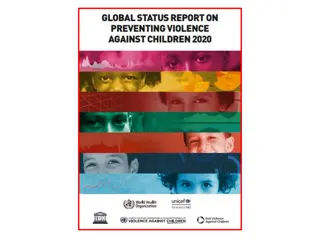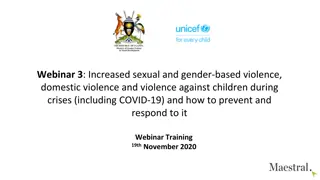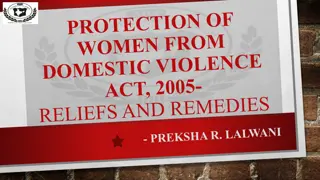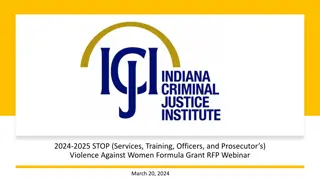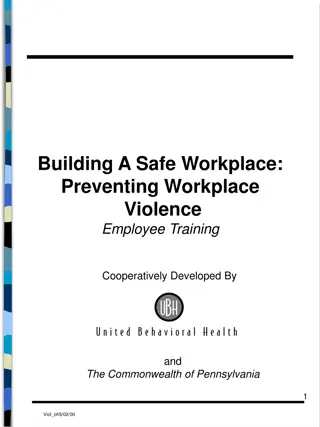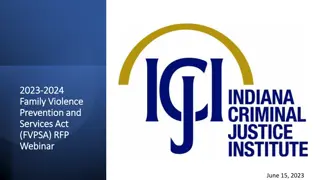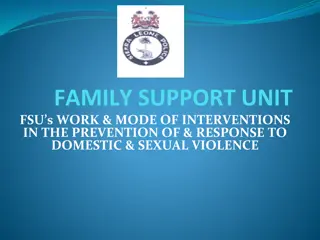Addressing Family Violence in Health Services: Key Insights
Understanding and responding to family violence is crucial in healthcare settings. This content explores the impact of domestic violence against women, including physical and psychological trauma, and the expectations of identifying such cases. It also highlights the barriers health practitioners face in asking about domestic violence.
Download Presentation

Please find below an Image/Link to download the presentation.
The content on the website is provided AS IS for your information and personal use only. It may not be sold, licensed, or shared on other websites without obtaining consent from the author. Download presentation by click this link. If you encounter any issues during the download, it is possible that the publisher has removed the file from their server.
E N D
Presentation Transcript
Enabling health services response to family Enabling health services response to family violence violence KELSEY HEGARTY KELSEY HEGARTY K.HEGARTY@UNIMELB.EDU.AU K.HEGARTY@UNIMELB.EDU.AU CHAIR OF FAMILY VIOLENCE PREVENTION CHAIR OF FAMILY VIOLENCE PREVENTION W www.saferfamilies.org.au T twitter.com/safer_families I instagram.com/saferfamiliescentre
DOMESTIC VIOLENCE against women PHYSICAL TRAUMA PSYCHOLOGICAL TRAUMA FEAR & CONTROL Injury & Death musculoskeletal soft tissue genital 0ther injuries Mental Health PTSD anxiety/depression eating disorders suicidality Sexual & reproductive health Unsafe sex Unwanted pregnancy STD s Substance Abuse alcohol other drugs tobacco Perinatal/Maternal Health low birth weight prematurity miscarriage Non-communicable Diseases cardiovascular disease hypertension Somatoform irritable bowel chronic pain WHO 2013
Strangulation/Traumatic brain injury Strangulation/Traumatic brain injury TBI STRANGULATION Ongoing poor concentration or memory problems Difficulty swallowing, speaking or breathing Focal neurological signs New communication difficulties Carotid bruit Persistent altered mood or cognitive impairment Raised intrvascular pressure- petechiae, subconjunctival haemorrhage Personality or behavoural changes Subcutaneous emphysema History of loss of consciousness or incontinence Visible bruising or bony deformity
Expectations of Identification Expectations of Identification 34 studies 34 studies Provide universal education suggesting that all women be given information to understand intimate partner abuse to facilitate disclosure Create a safe and supportive environment for disclosure emphasised need for the HCP to demonstrate care and confidentiality in their approach It s about how you ask highlighting the importance of fostering trust and rapport when enquiring about intimate partner abuse Korab-Chandler 2022 SAFER FAMILIES
What stops you asking about DV? What stops you asking about DV?
What stops health practitioners asking? What stops health practitioners asking? 29 studies 29 studies Only around 1 in 10 health professionals ask about DV Some of the barriers they talk about are: They may find it difficult to tolerate helplessness they feel when patients talk about their abuse or when their own traumatic abuse experiences are evoked System issues of lack of time or skills or referral options I can t interfere - belief DV is a private matter and fears of causing harm by offending the patient or fear of the perpetrator I don t have control - frustration when women do not follow their advice e.g., when patient returns to the partner after leaving I won t take responsibility - beliefs that addressing DV should be someone else s job or that DV is not common in their clinic Tarzia 2021
Asking about DV Asking about DV- - funnelling approach funnelling approach How is your relationship? What happens when you argue? What happens when he gets angry? Are you afraid of your partner? Sometimes partners use physical force. Is this happening to you? Has your partner ever physically threatened or hurt you? Have you felt humiliated or controlled by your partner? What is the worst thing that has happened in your relationship? Hegarty 2011, 2016
ACTS Identification Tool ACTS Identification Tool Has your partner (or family member) done something that made you or your children feel Afraid? Have they: Controlled your day-to-day activities or humiliated you? Threatened to hurt you in any way? Slapped, hit, kicked or otherwise physically hurt you in any way? Questions to identify immediate risk Do you feel safe when you leave here today? Do you have any immediate concerns about the safety of your children or someone else in your family? Hegarty 2020
Speaking on the phone/video Speaking on the phone/video Check the patient is alone e.g. I would like to ask you some personal questions. Its important that you are alone. Are you alone? or Can anybody overhear? and Is this a safe time to talk? or Is it okay to continue the conversation? If no then tell them you will call them back the next day and propose sometimes If you hear or see somebody in the background This consultation requires by law that you are alone. Could I ask for the person in the background to leave please? If alone then establish a code so that you know you should end the call e.g. Thanks but I m not interested or I have other things to do or wrong number 1 0
Listen to the patient closely, with empathy, and without judging Listen WHO Clinical Handbook - LIVES about needs and concerns. Assess and respond to various needs and concerns Show that you understand and believe her. Assure her that she is not to blame Inquire Validate Discuss a plan to protect themselves and their children from further harm Enhance safety Help them connect to information, services and social support. Support
Validation statements Validation statements Everybody deserves to feel safe at home. You don t deserve to be hit or hurt. It is not your fault. I am concerned about your safety and well-being. You are not alone. I will be with you through this, whatever you decide. Help is available. You are not to blame. Abuse is common and happens in all kinds of relationships. It tends to continue. Abuse can affect your health and that of your children in many ways. I am interested in supporting you.
Safety questions Safety questions About the person using domestic and family violence Has any physical violence increased in severity or frequency in the last year? Have they recently: a) Been obsessively jealous or possessive of you? b) Assaulted you when you were pregnant? c) Threatened or used a weapon against you? d) Tried to choke or strangle you? e) Forced you to have sex or participate in sexual acts when you did not wish to? f) Threatened to kill you?
Safety questions Safety questions About you Do you believe they are capable of killing or seriously harming you? Do you believe they are capable of killing or seriously harming children or other family members? About your children Have they ever threatened to harm the children? Have they ever harmed your children? About imminence Have you recently separated from your partner? (IPV only)
Safety Planning Safety Planning It includes where to go in an emergency, who to contact and what to take: Compiling a list of emergency numbers Helping to identify a safe place to go to and how she will get there Identifying family and friends who can provide support Ensuring can access credit, and Providing a safe place to store valuables and important documents. Working to keep victims safe has been shown to be the best way to keep children safe When the children are at imminent risk of harm contact intake and response, contact the Child Protection Unit in your area
CARE Model HOW to respond Tarzia 2020
What would help you address DV? What would help you address DV?
Trauma and Violence informed care and practice Trauma and Violence informed care and practice Clinic level Individual level How aligned is your clinic with core principles of safety, trustworthiness, choice, collaboration and empowerment? Does your clinic operate in a way that would minimise re- traumatisation for survivors? How does your clinic emphasise physical and emotional safety for all patients and staff? How attuned are you to the possibility of trauma in the lives of all patients? Do you have a strengths-based approach providing hope and possibilities for connection? What could you change to become more trauma informed? https://equiphealthcare.ca/resources/toolkit/trauma-and-violence-informed-care/ 1 8
CATCH MODEL 47 studies Commitment/Advocacy/Trust/Collaboration/Health system Health Practitioners Readiness to address family violence Adopting advocacy approach Having commitment Trusting the relationship Collaborating with a team High Health System Support Low Health System Support
Health System Model Health System Model The model operates at many levels: Leadership and governance- policies Health workforce development- training, practitioner support, designated champions Service delivery- protocols, referral networks established Coordination- internal/external referrals, community linkages Financing Information system and sharing-monitoring and evaluation Health infrastructure- environment
Resources Resources READINESS program www.saferfamilies.org.au/readiness-program RACGP The White Book www.racgp.org.au/clinical-resources/clinical-guidelines/key-racgp- guidelines/view-all-racgp-guidelines/abuse-and-violence/about-this-guideline KELSEY HEGARTY KELSEY HEGARTY WWW.MJA.COM.AU/JOURNAL/2022/217/3 K.HEGARTY@UNIMELB.EDU.AU K.HEGARTY@UNIMELB.EDU.AU CHAIR OF FAMILY VIOLENCE PREVENTION CHAIR OF FAMILY VIOLENCE PREVENTION W www.saferfamilies.org.au T twitter.com/safer_families I instagram.com/saferfamiliescentre
References References World Health Organization. Global and regional estimates of violence against women: prevalence and health effects of intimate partner violence and non-partner sexual violence. Geneva, Switzerland: 2013. World Health Organization. Responding to intimate partner violence and sexual violence against women: WHO clinical and policy guidelines. Geneva, Switzerland: WHO, 2013. Australian Institute of Health and Welfare. Family, domestic and sexual violence in Australia 2018. Cat. no. FDV 2. Canberra: AIHW; 2018. Hegarty K et al. Health practitioners readiness to address domestic violence and abuse: A qualitative meta- synthesis. PLoS One. 2020 Hegarty K et al. Identifying intimate partner violence when screening for health and lifestyle issues among women attending general practice. AJPH. 2012 Hegarty K et al. Identifying and responding to men who use violence in their intimate relationships. AFP 2016 45(4):176. Tarzia L et al. Women s experiences and expectations after disclosure of intimate partner abuse to a healthcare provider: a qualitative meta-synthesis. BMJ Open 2020 Tarzia L et al. Personal barriers to addressing intimate partner abuse: a qualitative meta-synthesis of healthcare practitioners experiences. BMC Health Serv Res 2021
